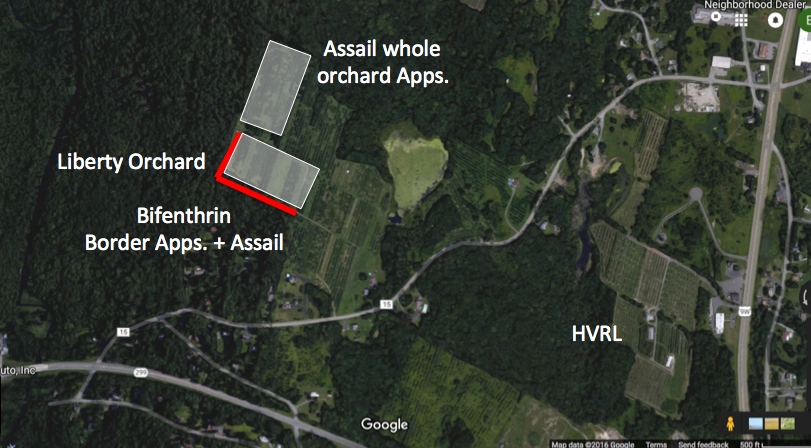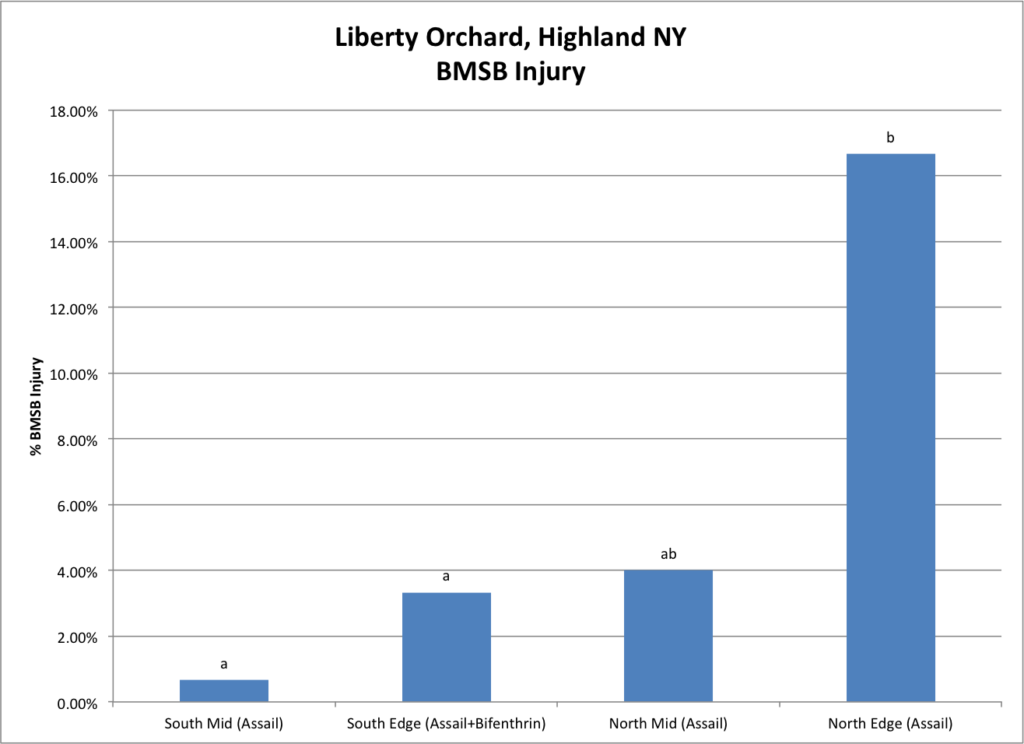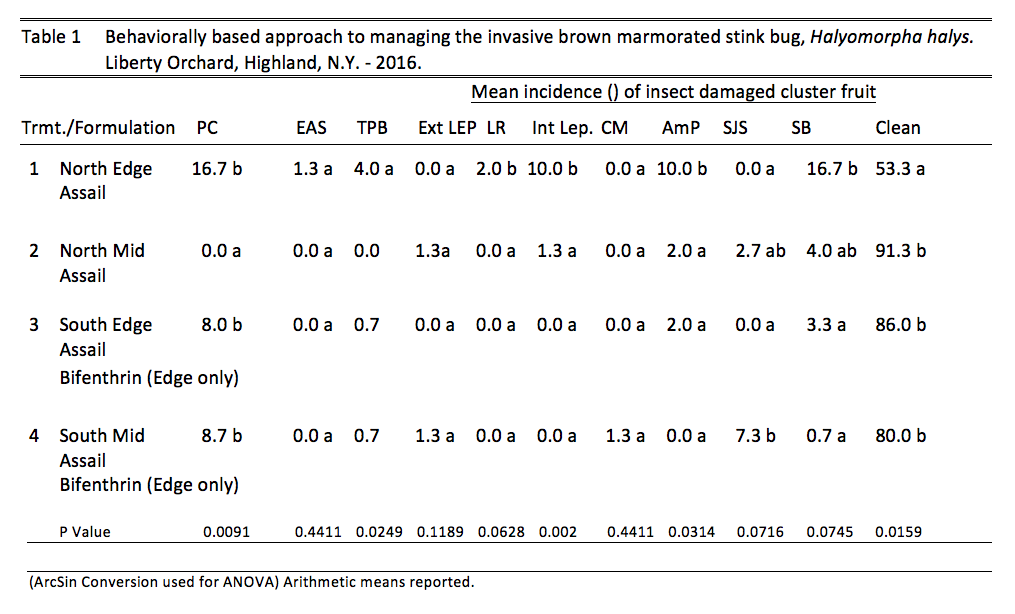Final report for ONE16-263
Project Information
The 2016 season was a year of very low BMSB populations across much of NY state. The replication of this work during seasons of high infestation levels would confirm the effectiveness of this management strategy.
Trapping across the Hudson valley resulted in very few BMSB captures, although nets accumulated larger numbers on average than traps.
Multiple forms of outreach were given and ongoing results are recorded at the lab website:
Introduction:
The Asian invasive brown marmorated stink bug (BMSB), Halyomorpha halys (Stal), has been present in the northeast since 1996 (Hoebeke and Carter 2003). First confirmed on Adams Island in Allentown, Pennsylvania the insect has been detected in 43 states and two Canadian Provinces BMSB was first found in PA in 1997 (Northeast IPM Center 2017). It has been observed throughout the southern Hudson Valley for the past 9 years with the first BMSB confirmation of movement into the Hudson Valley in December 2008. The BMSB is extremely polyphagous, feeding on over 200 host plants including ornamental plants, small fruit, grape, tree fruit, field and vegetable crops. Economic losses in the mid-Atlantic United States and New York were documented in 2010 with over $37 million in apple crop loss and 100% losse in peaches, and 20% loss of late season crop in 3 NY counties in 2012.
The pest has one to two generations per year in the mid-Atlantic and Northeast depending on seasonal temperature. The insect requires 13.5 hours of day length to initiate emergence from overwintering sites, used as the initial biofix. Calculation of 135 degree days (DD) (base 57.2°F) from the biofix is used to determine first egg deposit onto foliage, and an additional 964 DD for BMSB eggs to develop through five instar stages to the adult form. (Wilson, J. et.al. 2016). A second generation will be initiated if the adult has the required day length to begin mating and deposition of eggs in the late summer and fall. We have observed in the Hudson Valley clusters of 2nd generation egg laying in sites conducive to earlier seasonal degree-day development. In two of the past three years we’ve observed a second generation develop in mid-late August during regional voltinism studies conducted at the Hudson Valley Research Laboratory in Highland, NY. The rise of a sporadic second generation of BMSB from mid-August through mid-November has caused significant injury to late season crops and exponential increases in migrations to homes.
The BMSB home invasions have been documented in both urban environments and lower to mid-Hudson Valley regional fruit and vegetable farms throughout the growing season by researchers. During the fall of each year in regions where the BMSB is on the rise, the pest migrates locally from forest and ornamental trees to overwintering sites such as upper canopy of dead forest trees, 20% of which average 6 adults / tree of infested forest. Insects also overwinter as adults in manmade structures such as garages, office buildings, urban, suburban and rural homes. Its presence is most often met with a seasonal apprehension and fear by many homeowners who seek urban pest management advise and answers to questions and concerns. Documentation of these changes in migration and increasing concerns by homeowners on how best to deal with these infestations throughout the state have been made through citizen science outreach projects, established by the Hudson Valley Research Laboratory (Jentsch Lab - Citizen Science Project) for education, public engagement and mapping the spread of BMSB throughout the state.
The use of mapping sites developed for homeowners (iMapinvasives 2017; EDDMaps/BMSBNY 2017) provides a digital platform for the submission of images of insects for researchers to validate BMSB presence in the home, while educating the public on how to best manage the insect in their home. To date over 5277 individual submissions have been made, many including images for mapping BMSB in exact home locations or host plant sightings, increasing our knowledge of migration and population density. The use of traditional media including newspaper, magazines, television, and digital media using news sites, internet based web or blog sites, bounce feeds and search engines have provided the individual easy access to information on the brown marmorated stink bug. During interviews with HVRL staff, Citizen Science links to our blog site can reside within media sites for the audience to access and participate in documenting sightings of BMSB.
BMSB has been documented to cause the highest degree of crop injury along the agricultural woodland interface within a 90’ perimeter of tree fruit and vegetable fields. In 2012 damage assessments of the late apple variety Pink Lady, we observed a range of feeding along the perimeter 30’ row between. Work conducted by Anne Nielsen at Rutgers University demonstrated effective BMSB management using border applications of efficacious insecticides, thereby reducing insecticide use, retaining orchard beneficial insect populations and reducing management costs.
This insect spends the early parts of its life in forested areas, typically rearing young on the leaves and seeds of deciduous trees, particularly the Asian invasive Tree of Heaven Ailanthus altissima, a favored host. Previous research indicates that BMSB infestations are highest adjacent to these trees. Ergo, it stands to reason that BMSB damage would be clustered along borders, and that the addition of a border spray could increase control without the need for additional sprays across the block.
Our objective was to determine if a border spray in an orchard would be sufficient to protect not only that border, but the rows within the block. We anticipated a strong level of control in both the sprayed border and the block's interior. This hypothesis is based on the migratory habits of BMSB, which indicate that these insects move from forest edges to developing fruit late in the season, feeding on the nearest trees in higher numbers than those in the interior of a block.
Experimental Design: This study focuses on the behavior of the brown marmorated stink bug in pest management management decision making The insects local movement to and from arboreal habitat and its aggregation along the perimeter of a crop provides management strategies incorporating interception and repellency of the pest through the use of perimeter insecticide applications.
The project employs the use of a synthetic duel composite aggregation pheromone in trap monitoring to assess population density. Stink bug aggregation pheromone in the form of aldehydes are utilized for communication during movement, mate, food and shelter finding for overwintering. The BMSB synthesized aggregation pheromone compounds ((3S,6S,7R,10S)-10,11-epoxy-1-bisabolen-3-ol and (3R,6S,7R,10S)-10,11-epoxy-1-bisabolen-3-ol, were identified as the main components of a male-produced aggregation pheromone of the brown marmorated stink bug. These are produced and distributed by AgBio (agbio-inc.com/stink-bug-traps.html), employed to monitor the insect during the growing season, and effectively used in attract and kill stations employing Zero Fly™ pyrethroid impregnated netting to reduce populations. As adult BMSB migrate from one crop or forested edge to another crop, various traps such as black lights, Tedders pyramid traps or sticky traps, placed along the crop perimeter, are used to monitor the presence and potential threat from BMSB crop feeding. The aggregation pheromone is synergized by the addition of methyl (E,E,Z)-2,4,6-decatrienoate (MDT), employed from first emergence of the overwintering adult to the end of the season. An action threshold of 10 adult BMSB /trap /week for tree fruit pest management is used as the trigger for application.
Upon achieving trap threshold, a perimeter orchard applications of an effective BMSB insecticide would be employed. In this study a 5-acre block of Red Delicious apple was used, provided by Liberty Orchard in Highland NY. The block was bordered to the north and south by woodlands, We used a split block design to demonstrate the efficacy of late season perimeter applications for stink bug management. The need for late season insect pest management across the entire block was made using Assail 30SG. This material is a neonicotinoid in IRAC Class 3, used primarily for apple maggot and codling moth management with moderate efficacy on the early BMSB nymph stages and very low efficacy against the adult BMSB. The Assail was applied to the farm using a tractor trailered PTO powered airblast delivering 100 GPA using 175 PSI on a 14d schedule from first apple maggot adult flight beginning on 11th July, through 15th August, 2016.
Cooperators
Research
Although we monitored sites for BMSB, populations of BMSB at Crist Orchad and Hepworth Farm in Campbell Hall and Marlboro sites were below threshold for treatment.
At the Liberty Orchard in Highland, NY in which BMSB pheromone trapping achieve action threshold, on-tree fruit damage ratings were performed at the end of the season on two treatment blocks of mature apple trees. Corresponding to the map, the South block was treated with Biftenthrin on the borders only, and Assail across the block. The North block was treated with only Assail across the block.
50 fruit per 3 trees were examined, in both the edge and the middle of each separate blocks (total of 300 fruit per treatment, 150 from edge, and 150 from middle). Assessments were made in-tree, with smaller subsamples returned to lab for positive ID of BMSB feeding sites. Fruit on each tree was sampled randomly, taken from each quadrant and at different heights along the tree.
Liberty Orchard Red lines on map indicate locations of Bifenthrin border application. Image: Google Earth
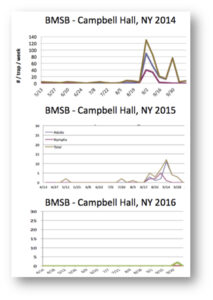
We observed a significant decline in BMSB populations while monitoring BMSB in 2016. During the 2015-16 winter, temperature fluctuations during the weeks of December 20th to January 10th may have played a significant role in BMSB population reductions from 2014 to 2016 exhibited in monitoring graphics from the Campbell Hall orchard site. During this period temperatures ranged from 71oF on Dec. 24th to 13oF on the 4th, and 10oF on the 6th of January, 2017 resulting in a 57oF temperature drop within 12 days. Temperature remained below 16oF for a 5 day period then bounding back to 65oF on January 10th. During this period 3.1" of rain fell in Highland,NY coupled with following high winds. These compounding conditions may have increased metabolic activity and low insect overwintering resilience creating unfavorable conditions for survival in the BMSB populations as observed across the region in 2016.
During our assessment of data we calculated percent of BMSB injury. To stabilize variance in our data, we transformed the data using arcsine (Sqrt(x)) prior to our analysis. Mean separation was made using Fishers Protected LSD (P ≤ 0.05). Treatment means followed by the same letter are not significantly different. Arithmetic means reported.
BMSB injury in orchard. Assail sprayed across orchard, South Edge received an extra Bifenthrin spray. p value: 0.0745
Stink bug damage in the South Block was lower overall, and the edge, which was treated with an extra spray of Bifenthrin was significantly less infested than the edge of the North Block (Assail alone). These data indicate that edge sprays not only protect the edges themselves, but extend protection to the interior rows within their blocks, as the middle of the South Block was lower than the middle of the North.
Additionally, ratings of other common apple insect pest damage were taken and analyzed in the same manner. Results indicate that border bifenthrin sprays protect against other insect damage in the middle of the block as well.
The stink bug complex, including the arboreal native green stink bug and invasive brown marmorated stink bug can cause significant injury to tree fruit. This often occurs It appears from our data in a year with moderate to low applications, injury to fruit was reduced significantly in border trees to which insecticides were made in comparison to block without insecticides efficacious against the stink bug complex.
Education & Outreach Activities and Participation Summary
Participation Summary:
The Jentsch Lab blog site (https://blogs.cornell.edu/jentsch/) provided articles on BMSB management, regional threshold data, illustrations and recommendations based on the research conducted in this project over the past two seasons.


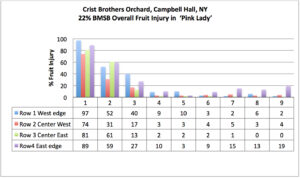
Learning Outcomes
Employing boarder applications in late season apple varieties to reduce injury to crop prior to harvest
Project Outcomes
The implications to the field of IPM in which these principles are followed can be quite substantial. These data indicate that the addition of border applications protect reduce infestation substantially across the entire block. Less material is applied, saving money on both material, labor, and fuel, and resulting in significant protection against BMSB injury while conserving late season predatory and parasitic complex of beneficial insects.
While elimination of cover sprays to control BMSB is not likely, the use of strategic border sprays can be a useful tool to reduce volume of orchard spray material. In the trials this year, significant control was achieved through the use of border applications, reducing the need for the most efficacious insecticide, Bifenthrin, to be applied to the entire block.
These finding present a method to reduce insecticide use, saving time and labor, equipment usage, conservation of non-target beneficial complex and less disruption of arthropods such as the phytophagous mite complex (two-spotted spider mite and European red mite) that often flare-up when late season beneficial insects are removed using broad spectrum materials.
As a small trial, using only a single orchard site due to the lack of BMSB populations during our seasonal monitoring of the pest, future research studies utilizing additional a broad selection of sites, material options, and varieties of apple to garner a broader understanding of the systems should be conducted By expanding the project to a greater diversity of orchard sites with measurably different forest edge tree complexes containing hosts of BMSB, our ability to predict the efficacy of border sprays depending on the local ecosystem would improve our knowledge and possibility of greater predictiveness of this invasive insect pest. As seen from this study, there are years when management of BMSB on some sites is simply not warranted.
